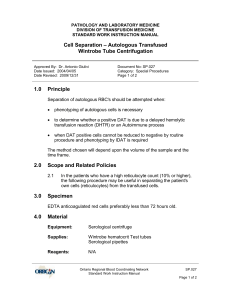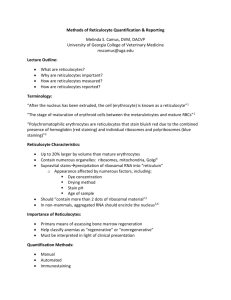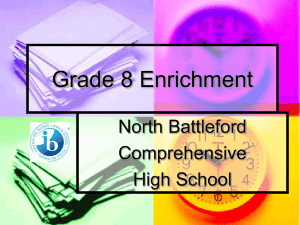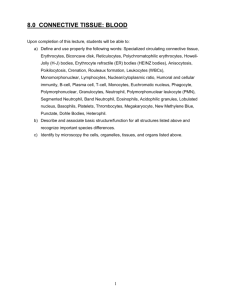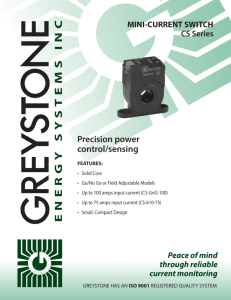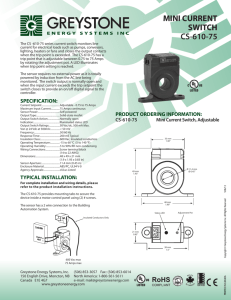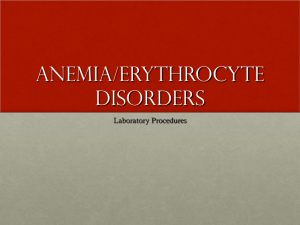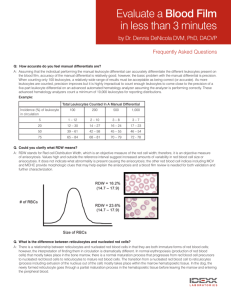Enrichment of reticulocytes from whole blood
advertisement
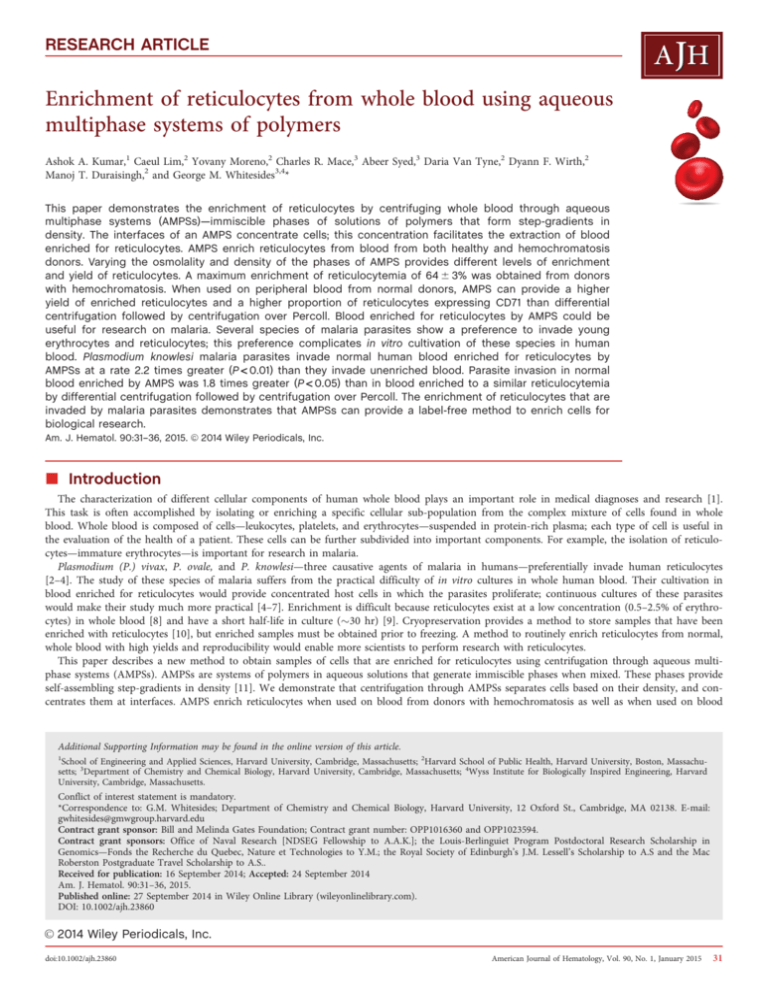
A JH RESEARCH ARTICLE Enrichment of reticulocytes from whole blood using aqueous multiphase systems of polymers Ashok A. Kumar,1 Caeul Lim,2 Yovany Moreno,2 Charles R. Mace,3 Abeer Syed,3 Daria Van Tyne,2 Dyann F. Wirth,2 Manoj T. Duraisingh,2 and George M. Whitesides3,4* This paper demonstrates the enrichment of reticulocytes by centrifuging whole blood through aqueous multiphase systems (AMPSs)—immiscible phases of solutions of polymers that form step-gradients in density. The interfaces of an AMPS concentrate cells; this concentration facilitates the extraction of blood enriched for reticulocytes. AMPS enrich reticulocytes from blood from both healthy and hemochromatosis donors. Varying the osmolality and density of the phases of AMPS provides different levels of enrichment and yield of reticulocytes. A maximum enrichment of reticulocytemia of 64 6 3% was obtained from donors with hemochromatosis. When used on peripheral blood from normal donors, AMPS can provide a higher yield of enriched reticulocytes and a higher proportion of reticulocytes expressing CD71 than differential centrifugation followed by centrifugation over Percoll. Blood enriched for reticulocytes by AMPS could be useful for research on malaria. Several species of malaria parasites show a preference to invade young erythrocytes and reticulocytes; this preference complicates in vitro cultivation of these species in human blood. Plasmodium knowlesi malaria parasites invade normal human blood enriched for reticulocytes by AMPSs at a rate 2.2 times greater (P < 0.01) than they invade unenriched blood. Parasite invasion in normal blood enriched by AMPS was 1.8 times greater (P < 0.05) than in blood enriched to a similar reticulocytemia by differential centrifugation followed by centrifugation over Percoll. The enrichment of reticulocytes that are invaded by malaria parasites demonstrates that AMPSs can provide a label-free method to enrich cells for biological research. C 2014 Wiley Periodicals, Inc. Am. J. Hematol. 90:31–36, 2015. V 䊏 Introduction The characterization of different cellular components of human whole blood plays an important role in medical diagnoses and research [1]. This task is often accomplished by isolating or enriching a specific cellular sub-population from the complex mixture of cells found in whole blood. Whole blood is composed of cells—leukocytes, platelets, and erythrocytes—suspended in protein-rich plasma; each type of cell is useful in the evaluation of the health of a patient. These cells can be further subdivided into important components. For example, the isolation of reticulocytes—immature erythrocytes—is important for research in malaria. Plasmodium (P.) vivax, P. ovale, and P. knowlesi—three causative agents of malaria in humans—preferentially invade human reticulocytes [2–4]. The study of these species of malaria suffers from the practical difficulty of in vitro cultures in whole human blood. Their cultivation in blood enriched for reticulocytes would provide concentrated host cells in which the parasites proliferate; continuous cultures of these parasites would make their study much more practical [4–7]. Enrichment is difficult because reticulocytes exist at a low concentration (0.5–2.5% of erythrocytes) in whole blood [8] and have a short half-life in culture (30 hr) [9]. Cryopreservation provides a method to store samples that have been enriched with reticulocytes [10], but enriched samples must be obtained prior to freezing. A method to routinely enrich reticulocytes from normal, whole blood with high yields and reproducibility would enable more scientists to perform research with reticulocytes. This paper describes a new method to obtain samples of cells that are enriched for reticulocytes using centrifugation through aqueous multiphase systems (AMPSs). AMPSs are systems of polymers in aqueous solutions that generate immiscible phases when mixed. These phases provide self-assembling step-gradients in density [11]. We demonstrate that centrifugation through AMPSs separates cells based on their density, and concentrates them at interfaces. AMPS enrich reticulocytes when used on blood from donors with hemochromatosis as well as when used on blood Additional Supporting Information may be found in the online version of this article. 1 School of Engineering and Applied Sciences, Harvard University, Cambridge, Massachusetts; 2Harvard School of Public Health, Harvard University, Boston, Massachusetts; 3Department of Chemistry and Chemical Biology, Harvard University, Cambridge, Massachusetts; 4Wyss Institute for Biologically Inspired Engineering, Harvard University, Cambridge, Massachusetts. Conflict of interest statement is mandatory. *Correspondence to: G.M. Whitesides; Department of Chemistry and Chemical Biology, Harvard University, 12 Oxford St., Cambridge, MA 02138. E-mail: gwhitesides@gmwgroup.harvard.edu Contract grant sponsor: Bill and Melinda Gates Foundation; Contract grant number: OPP1016360 and OPP1023594. Contract grant sponsors: Office of Naval Research [NDSEG Fellowship to A.A.K.]; the Louis-Berlinguiet Program Postdoctoral Research Scholarship in Genomics—Fonds the Recherche du Quebec, Nature et Technologies to Y.M.; the Royal Society of Edinburgh’s J.M. Lessell’s Scholarship to A.S and the Mac Roberston Postgraduate Travel Scholarship to A.S.. Received for publication: 16 September 2014; Accepted: 24 September 2014 Am. J. Hematol. 90:31–36, 2015. Published online: 27 September 2014 in Wiley Online Library (wileyonlinelibrary.com). DOI: 10.1002/ajh.23860 C 2014 Wiley Periodicals, Inc. V doi:10.1002/ajh.23860 American Journal of Hematology, Vol. 90, No. 1, January 2015 31 RESEARCH ARTICLE Kumar et al. from normal, healthy donors. P. knowlesi multiplies at a higher rate in reticulocytes enriched by this method than in normal human blood or in blood enriched for reticulocytes by conventional means (i.e., differential centrifugation followed by centrifugation over Percoll). We exploit two differences between reticulocytes and mature erythrocytes—density and osmotic response to hypotonic and hypertonic environments—to enrich reticulocytes from whole blood to a maximum reticulocytemia of 64 6 3%. Background Current methods to obtain substantially enriched (>10% of erythrocytes) samples of reticulocytes are impractical, expensive, labor-intensive, or not satisfactory for routine use for applications that require reproducible yields and readily available sources of blood. These methods include culture and development of progenitors [12], affinity-based separation [13], differential centrifugation [14], and centrifugation over layered gradients [15]. We describe these methods in detail in the Supporting Information. Briefly, affinity-based separation and development of reticulocytes from progenitors can attain very high purities, but these procedures can be costly and, in the case of affinity-based separation, the recovery of undamaged cells is difficult [15]. Both differential centrifugation and centrifugation enrich reticulocytes through a physical characteristic: density. Density provides a label-free characteristic to use in enriching reticulocytes. The average density of reticulocytes is slightly lower than that of mature erythrocytes (Dq 0.009 g/cm3) [16,17]. The reticulocyte population is concentrated in the least dense quarter of the distribution of densities of erythrocytes [17,18]. This difference in density provides the basis for enrichments using differential centrifugation and centrifugation over layered gradients. To attain high yields and purities, however, these methods often rely on blood from sources with elevated reticulocytemias (>2.5% [8]), such as cord blood or blood from patients with hemochromatosis [2,19]. These sources are useful, but not as widely available as peripheral blood from normal, healthy donors. AMPSs provide steps in density suitable for enriching reticulocytes from peripheral blood. Each phase of an AMPS consists predominantly [60–95% (w/v)] of water, and contains concentrations of polymers or surfactants ranging from 1 to 40% (w/v) (i.e., micromolar to millimolar). These compositions determine the physical properties of the phases of an AMPS (e.g., density, viscosity, ionic strength, and refractive index). The phases order, on settling or on centrifugation, according to their densities [20]. Many AMPSs are biocompatible [21] and have been used for separations of cells by partitioning [22–26]—that is, by a process based on the preferential interaction of the surfaces of different types of cells with the components of the different phases [27]. Partitioning methods result in relatively low enrichment of reticulocytes (<2%) [26]. The differences in the densities of the phases of AMPSs provide a means to perform density-based separations [11]. The interfaces between phases mark discontinuities (on the molecular scale) between continuous fluid phases of different density. The densities (qA and qB) of the phases above and below the interface establish the range of densities for components (qC) that will localize at the interface (qA > qC > qB). The interfacial surface energy between the phases of an AMPSs is remarkably low (from nJ/m2 to mJ/m2) [28]; a low interfacial surface energy reduces the mechanical stress on cells as they pass through the interface. Compared to layered gradients in density (e.g., Percoll, Optiprep, or Nycodenz), AMPSs offer several advantages: (i) they are thermodynamically stable, (ii) they self-assemble rapidly (t 15 min, 2000g) on centrifugation or slowly (t 24 hr) on settling in a gravitational field, (iii) they can differentiate remarkably small differences in den- 32 American Journal of Hematology, Vol. 90, No. 1, January 2015 sity (Dq < 0.001 g/cm3), and (iv) they provide well-defined interfaces that facilitate both the identification and extraction of subpopulations of cells by concentrating them to quasi-two-dimensional surfaces. We previously demonstrated that separating cells by density in AMPSs provides a useful method for identifying specific populations of cells, such as dense cells present in sickle cell disease [29]. The label-free separations attainable with AMPSs may also be useful in applications where the cells separated by density are required for biological assays that may be affected by the use of molecular labels. To our knowledge this work represents the first applications in which cells separated by AMPS are subsequantly used in a biological assay (i.e., invasion by malaria parasites). 䊏 Methods Materials. We purchased the following polymers: poly(ethylene glycol) (SigmaAldrich; MW 5 20000 Da), Ficoll (Sigma-Aldrich; MW 5 70000 and 400000 Da), dextran (Spectrum Chemical; 500000 Da), and poly(vinyl alcohol) (Polysciences; MW 5 3000 Da). We purchased phosphate-buffered saline (Lonza) at 103 concentration and diluted it to 13 using distilled, deionized water from a Milli-Q water purification system (Millipore). For stains, we used New Methylene Blue and Hemacolor (EMD) for slides and ReticONE (acridine orange) for flow cytometry. We used all reagents without further purification. We purchased Lymphoprep from Accurate Chemical, fluorescein isothiocyanate from Thermo Scientific, and Percoll from GE healthcare. For the parasite culture media, we purchased RPMI, hypoxanthine and sodium bicarbonate from Sigma, HEPES from EMD Biosciences, and Albumax from Invitrogen. We purchased human whole blood, collected over sodium heparin as an anticoagulant, from single healthy donors (vendor certified syphilis–, HTLV–, HIV–, HepB–, and HepC–) from Research Blood Components (Boston, MA). Whole blood units (approximately 500 mL in volume) collected from hemochromatosis patients undergoing therapeutic phlebotomy were obtained from the blood donor center at Brigham and Women’s Hospital, Boston, MA. The H Strain of Plasmodium knowlesi was obtained from the Biomedical Primate Research Center (Rijswijk, The Netherlands). The 3D7 Strain of Plasmodium falciparum was obtained from the Harvard School of Public Health (Boston, MA, USA). Characteristics of blood samples used. We used blood from two sources: a commercial supplier (Research Blood Components) and a hematology clinic (Brigham and Women’s Hospital, Boston). The blood from the commercial supplier was collected with an anticoagulant from normal, healthy individuals. The blood from the hematology clinic came from hemochromatosis patients undergoing treatment. Despite the hemochromatosis, the blood from many of these patients did not reveal a level of reticulocytes that was significantly higher than normal. In this work, all the blood that was used contained the clinically normal range of 0.5–2.5% reticulocytes before enrichment [8]. White blood cells were removed from the blood prior to use by passage through a leukocyte filtration device (Sepacell R-500). The removal of white blood cells is necessary for the cultivation of Plasmodium parasites. Choice of blood sources. One of the purposes of this study was to create a method to enrich reticulocytes from blood with normal levels of reticulocytes rather than sources that start at a higher level of reticulocytemia but may not be as widely available (i.e., cord blood). Our initial screening tests were performed with blood from donors with hemochromatosis, but without elevated reticulocytemia (2.5%) [8]. Anonymous blood samples came from patients with hemochromatosis who regularly had blood draws as therapy for the condition and whose blood would otherwise be discarded. These samples provided a plentiful and regular supply of blood for testing various formulations of AMPS and conditions of centrifugation. Once we narrowed down our choices of AMPS for enrichment, we evaluated the performance of the system in detail using blood samples from normal healthy donors. Normal blood samples were provided by an IRB-approved commercial vendor (Research Blood Components) and hemochromatosis blood was provided by Brigham and Women’s Hospital, Boston, as IRB-exempt discarded samples. Choice of AMPS. The choice of AMPSs to enrich reticulocytes from blood requires many considerations. When blood is layered on top of an AMPS, the region between the top phase and the blood forms a boundary of density like those found in layered gradients. This boundary is diffuse and unstable because plasma is soluble in the phases of AMPSs. Cells concentrated at the boundary, therefore, are not confined sharply, and the subsequent recovery of cells from the boundary region is more difficult than from a well-defined interface between two immiscible phases. The two phases of a two-phase AMPS provide two well-defined interfaces— one between the two phases of the AMPS, and one between the denser phase and the bottom of the container—in addition to the boundary that is formed with the blood. In this arrangement, one interface (that between the two liquid phases of the AMPS) collects the enriched reticulocytes, and one interface (that between the doi:10.1002/ajh.23860 RESEARCH ARTICLE Enriching reticulocytes with aqueous multiphase systems Figure 1. A hypertonic (u 5 330 mOsm/kg) AMPS of 11.6% (w/v) dextran Figure 2. The fraction of blood at the interface of several AMPSs is and 11.6% (w/v) Ficoll (qtop 5 1.086 g/cm3 and qbottom 5 1.089 g/cm3) provides a step-gradient in density capable of enriching reticulocytes from blood. Centrifugation of blood depleted of leukocytes over a column of the AMPS leaves the plasma above the top phase and a reticulocyte-rich layer of cells at the liquid/liquid interface (retics); the remaining erythrocytes pack below the bottom phase (packed cells). Arrows on the micrographs indicate reticulocytes. The bottom phase becomes pink from the presence of suspended cells that are nearly isodense with that phase and, hence, do not settle at an interface for the centrifugation parameters Used. enriched to a reticulocytemia over 50%. Filled, black symbols mark results from hypotonic (hypo)—square, isotonic (iso)—triangle and hypertonic (hyper)—circle—series of AMPSs where the volume ratio of blood to AMPS was kept constant at 1:4. The half-black, half-white and white circles illustrate hypertonic series with volume ratios of blood to AMPS of 4:4 and 8:4. Error bars depict the average deviation from the mean of triplicate experiments. denser phase and the bottom of the tube) collects the remaining erythrocytes. An AMPS with more than two phases could also enrich reticulocytes. Each additional phase could isolate a different population of cells, but would add to the complexity of the phase separation. To separate a reticulocyte-rich subpopulation from mature erythrocytes, we thus chose to use an AMPSs with two phases, also known as an aqueous two-phase system (ATPS) [20,30]. We surveyed several previously reported AMPSs (Supporting Information). A system prepared from dextran (MW 500 kDa) and Ficoll (MW 400 kDa) satisfied our two selection criteria: (i) the ability to create a small step in density to separate reticulocytes from mature erythrocytes and (ii) the ability to maintain physiological pH while allowing the tonicity to be tuned. In blood, the physiological reference range for pH is 7.38–7.44, and for osmolality is 285–295 mOsm/kg [8]. Changes to either of these parameters will result in changes to the morphology and density of blood cells. We describe methods to prepare and characterize the AMPSs that we use in this communication in the Supporting Information. We prepared a series of dextran–Ficoll AMPSs at various densities and osmolalities. We expected that differences between ion transport in reticulocytes and mature erythrocytes would enhance differences in density due to unequal responses to osmotic stress [15]. Osmolality thus provided an additional parameter to tune the separation of these cells based on density. A range of available densities and tonicities—controlled by the concentrations of polymers and salts in each phase—allowed us to investigate the influence of these factors on both the final purity and the yield of reticulocytes concentrated at the interface of the AMPS. Based on literature precedent, we expected an AMPS with a density of the bottom phase near 1.080 g/cm3 to isolate a band of reticulocyte-rich erythrocytes at the upper interface of the bottom phase [17]. We explored a range of densities for a bottom phase near this value. For hypertonic and hypotonic systems, we explored ranges of densities based on expected shifts in density from changes in hydration (Supporting Information Table SI). Formation and analysis of AMPS. A detailed protocol to produce and characterize AMPSs used in this work is provided in the Supporting Information. Characterization of samples enriched for reticulocytes. In addition to reticulocytemia, we also chose to characterize yield and scale for our separations. Yield and scale are important characteristics of reticulocyte enrichment for the cultivation of malaria parasites. Systems that scale well to large volumes (> 10 mL of blood) and attain >10 mL of packed reticulocytes would decrease the burden of time and doi:10.1002/ajh.23860 resources to maintain cultures of P. knowlesi, P. vivax, or P. ovale. Changing the volume ratio of blood to polymer affected the final enrichment of reticulocytes as a result of dilution (Supporting Information Figs. S1–S3). A constant volume ratio of blood to polymer, however, achieves reproducible results at different scales (Supporting Information Fig. S4). Details of the effects of volume ratio and scale are provided in the Supporting Information. Statistical methods. We used a paired, two-sided Student’s t test to test for significant differences between the logarithms of the parasitized erythrocyte multiplication rates (PEMRs) to compare blood from donors with different treatments. We also used this test for significance when evaluating the enrichments characterized by double staining. Results from technical replicates are reported as means of the technical replicates. 䊏 Results AMPSs can enrich reticulocytes to a high purity Upon sedimentation of 1 mL of blood through 4 mL of a hypertonic (u 5 330 mOsm/kg) AMPS of 11.6% (w/v) of dextran and 11.6% (w/v) Ficoll (qtop 5 1.086 g/cm3 and qbottom 5 1.089 g/cm3), we observed two layers of erythrocytes: one layer at the liquid/liquid interface between the two phases of the AMPS and one layer between the bottom phase and the container (Fig. 1). After extracting cells with a pipette and washing them in phosphate buffered saline (PBS), cells were stained either with New Methylene Blue (to visualize intracellular RNA in reticulocytes by microscopy) or with acridine orange (to quantify reticulocytes by flow cytometry). For hypertonic, isotonic, and hypotonic systems, we found specific densities of the dextran–Ficoll AMPS that provided highly enriched reticulocytes from blood with hemochromatosis (Fig. 2, Supporting Information Fig. S1). Supporting Information Table SI details the parameters of each AMPS and the results of each enrichment procedure. For small shifts in osmolality, the difference in density between an object and water scales with the osmolality (Supporting Information); the density of the best-performing hypotonic system is lower than that of the best-performing hypertonic system. A hypotonic (u 5 269 mOsm/kg) AMPS of 9.3% (w/v) dextran and 9.3% (w/v) American Journal of Hematology, Vol. 90, No. 1, January 2015 33 RESEARCH ARTICLE Kumar et al. TABLE I. Characterization by Double Staining for RNA (Retic) and CD71 of Enrichments from Normal Whole Blood Using AMPS (C1, C2, B3, A5) Versus Differential Centrifugation Followed by Percoll (DC-P) Retic (%) Treatment None C1[a] C2[a] B3[b] A5[b] DC-P[a] CD711 (%) Retic with CD711 (%) Retic yield Mean SD Mean SD Mean SD Mean (Min, Max) 1.8 11.6 16.7 12.9 11.5 18.2 0.4 6.9 10.1 6.5 5.9 13.6 0.3 4.8 7.8 6.2 4.9 5.7 0.1 3.2 5.3 3.4 2.6 4.7 16.4 37.5 44.3c 45.8 43.8 28.1 3.9 10.6 13.6 13.2 12.8 8.1 – 49.9 15.0 1.3 1.6 11.3 – [0.45,96] [0.19,49] NA NA [0.047,34] a Double staining on n 5 8 subjects. Counts for yield were done on n 5 4. Three donors did not yield any detectable cells at the B3 and A5 interface. As a result, double staining was done on n 5 5 subjects and counts for yield were done on n 5 1. c Significantly (P < 0.05) higher enrichment than DC-P. b Ficoll with qtop 5 1.068 g/cm3 and qbottom 5 1.072 g/cm3 enriched reticulocytes to 55 6 8% at the interface of the AMPS (Fig. 2). Although this system provided the highest purity of enrichment for a 1:4 volume ratio of blood to AMPS, it collected less than 107 cells (1 mL of packed cells) at the interface. We explored different volume ratios of blood to AMPSs to see if we could attain similar purities with a lower relative volume of AMPSs (Fig. 2, Supporting Information Fig. S1). A 1:1 volume ratio of blood to a hypertonic (u 5 336 mOsm/kg) AMPS of 11.4% (w/v) dextran and 11.4% (w/v) Ficoll (qtop 5 1.084 g/cm3 and qbottom 5 1.088 g/cm3) provided the greatest enrichment of reticulocytes (up to 64 6 3%) at the interface of the AMPS (Supporting Information Fig. S2). The difference in performance for different ratios of volumes may be due to dilution effects of plasma that is pulled by blood cells during centrifugation (Supporting Information Fig. S3). Variations between individuals can lead to significant differences in the performance of density-based separation methods. We enriched reticulocytes using four dextran–Ficoll AMPSs from the initial screen with blood from four different donors with hemochromatosis (Supporting Information Table SII) as well as from four different healthy donors (Table I). Increasing the ratio of the volume of blood to polymer to 1:1 (i.e., 4 mL blood on 4 mL of AMPS) increased the yield of reticulocytes as measured by flow cytometry (Supporting Information). To characterize the erythrocytes enriched from normal whole blood, we performed double staining for RNA, found in immature erythrocytes and CD71, the transferrin receptor released through exosomes during erythrocyte maturation, and thus a marker of young reticulocytes [31]. The degree of enrichment and final yield varied between donors (Supporting Information Table SIII). In general, we found that the hypertonic AMPS provided higher yield than the isotonic and hypotonic AMPS. In blood from healthy donors, the isotonic and hypotonic systems yielded such small volumes that quantification of yield was not possible in some cases. We also compared our systems to a common enrichment method: differential centrifugation of blood followed by centrifugation of the enriched fraction over a layered gradient of Percoll (DC-Percoll). All methods varied greatly between donors. With normal donors, the yield from the AMPS system C1 was, on average, six times higher than the the yield from DC-Percoll (P 5 0.01). We also found that the percent of reticulocytes that were CD711 was significantly higher in enrichments done with system C2 (44.3%) than with DC-Percoll (28.1%) (P 5 0.04); C1 also had a higher amount of CD711 reticulocytes (37.5%), but at a lower level of significance (P 5 0.11). 34 American Journal of Hematology, Vol. 90, No. 1, January 2015 Figure 3. Reticulocytes enriched through a dextran–Ficoll AMPS are invaded by P. knowlesi. Parasites cultured in unenriched blood (None), AMPS-enriched blood (AMPS), and DC-Percoll-enriched human blood (DCPercoll) show invasion after 18 hr in both blood from donors with hemochromatosis (A) (n 5 8) and healthy donors (B) (n 5 6). P. knowlesi parasitemia increased more in media that contained blood enriched for reticulocytes by centrifugation in a dextran–Ficoll AMPS than in either untreated blood or that enriched by DC-Percoll (P < 0.05). The horizontal bars indicate the mean parasitized erythrocyte multiplication rate (PEMR) for each invasion assay. Each symbol represents average results from a different donor performed in triplicate. Malaria parasites invade reticulocytes enriched by centrifugation through an AMPS To ensure that we obtained a sufficient number of reticulocytes to perform an invasion assay after enrichment, we chose system C1 (Table I). We layered 25 mL of blood over 25 mL of the dextran– Ficoll AMPS in 50 mL conical tubes. After centrifugation, we collected the cells from the interface using sterile technique and washed them three times in a 100-fold volume of PBS. After washing, the morphology of the cells was comparable to the morphology before doi:10.1002/ajh.23860 RESEARCH ARTICLE Enriching reticulocytes with aqueous multiphase systems exposure to AMPS (Supporting Information Table SIV, Fig. S5); these cells were then used for culture. We also prepared enriched samples of reticulocytes using the DC-Percoll method (Supporting Information). For each invasion assay, we matched the enrichment of reticulocytes from DC-Percoll with that from AMPSs by diluting the more enriched sample with homologous whole blood. Supporting Information Table SV details the matched reticulocytemia of enrichments from different donors using the two different methods of enrichment. We added purified late-stage parasites (e.g., late trophozoites and schizonts) of P. knowlesi H strain to the culture medium at a parasitemia—the percentage of erythrocytes that contain parasites—between 0.5 and 2.5%. This mixture of enriched reticulocytes and parasites was incubated at culture conditions standard for malaria parasites for 18 hr [4]. This time is sufficient to allow late-stage parasites to mature and rupture, and then to release infectious merozoites into the suspension of erythrocytes enriched in reticulocytes. We quantified the ability of parasites to reinvade erythroyctes and reticulocytes by the parasitized erythrocyte multiplication rate (PEMR)—the ratio of the initial parasitemia to the parasitemia after 18 hr. If merozoites can invade the AMPS-enriched reticulocytes, we would expect to see an increase in the parasitemia after 18 hr (PEMR > 1); a PEMR > 1 is necessary for long-term cultivation of malaria parasites. Reinvasion is an important step in culture that depends in part on the surface of the host cells; if residual polymers on the surface of reticulocytes compromised cultivation, we expected the effect would be most pronounced during reinvasion. Figure 3 shows the results from invasion assays using both normal and hemochromatosis blood enriched by AMPS, blood enriched for reticulocytes by DC-Percoll and blood with no enrichment. Blood enriched by DC-Percoll provides a benchmark comparison for reticulocyte enrichment. Reticulocytemia in enriched samples was between 2.1 and 22%. For both types of blood, the PEMR for samples enriched by AMPS was significantly better than either untreated blood or blood enriched by DC-Percoll (P < 0.05). Blood from eight subjects with hemochromatosis and six subjects with normal blood provided biological replicates. We performed three technical replicates with each subject. We prepared thin smears of the samples immediately after the introduction of late stage parasites to the blood samples and at 18 hr after cultivation. After staining the slides with Hemacolor rapid stain (EMD), we quantified the parasitemia of each sample (Supporting Information). Parasites showed better invasion in blood enriched by AMPS than in unenriched blood with PEMRs nearly double those from unenriched samples (P < 0.01) (Fig. 3). For both types of blood, the PEMR for samples enriched by AMPSs was significantly (P < 0.05) better than either untreated blood or blood enriched by DC-Percoll. In blood with hemochromatosis, the PEMR in blood enriched by AMPS was 1.5 times greater than that in blood enriched by DC-Percoll (P 5 0.046). The difference was even more pronounced in normal blood, with PEMR from AMPS being 1.8 times greater than from DC-Percoll (P 5 0.010). 䊏 Discussion We have demonstrated that sedimentation through AMPSs is a useful technique to separate cells by density. AMPSs concentrate cells at molecularly sharp interfaces that provide well-defined steps in density, and this concentration facilitates the enrichment of cell types 䊏 References 1. Bunn HF, Aster JC. Pathophysiology of Blood Disorders. New York: McGraw Hill Medical; 2011. pp 1–342. 2. Galinski M, Barnwell J. Plasmodium vivax: Merozoites, invasion of reticulocytes and considera- doi:10.1002/ajh.23860 that differ in density. Specifically, AMPSs can enrich reticulocytes from human whole blood. P. knowlesi H strain invades blood enriched for reticulocytes by AMPSs at a higher rate than it invades unenriched blood or blood enriched for reticulocytes by DC-Percoll. The ability to reproducibly enrich reticulocytes from normal, whole blood should benefit research involving reticulocytes, such as efforts to culture malaria species that preferentially invade reticulocytes (i.e., P. vivax, P. knowlesi, and P. ovale). Existing methods to enrich reticulocytes are not suitable for the routine enrichments that would be required for a sustainable continuous culture. Simple differential centrifugation (DC) provides a method to enrich reticulocytes from peripheral blood, but the enrichment is low (<3%) [14]; when used on hemochromatosis blood, DC can attain enrichments of 15% reticulocytes [7]. Affinity-based separation techniques and the direct growth of reticulocytes allows high purity (>90%) that is not matched by enrichments using AMPSs, but these methods are expensive and impractical for routine use [13]. DC-Percoll provides a means to enrich reticulocytes, but this method requires two separate centrifugation steps and two extraction steps; variation between steps compound to reduce reproducibility. Exposure to Percoll may also impair parasite development for specific strains of malaria parasites [32], and may, partly, explain the greater invasion of reticulocytes enriched by AMPS compared to those enriched by DC-Percoll. When used on peripheral blood from healthy donors, the overall yield and the fraction of reticulocytes that are CD711 is higher when using AMPS than using DC-Percoll (Table I). CD711 reticulocytes may be more susceptible to invasion by malaria parasites [33], and the higher levels of these reticulocytes attained by AMPS could also partly explain the increased rates of invasion we observe. Enriching reticulocytes through AMPSs retains the simplicity of differential centrifugation (layering blood over an AMPS adds only one step to the general procedure), but provides useful levels of enrichment (median reticylocytemia of 11%) from peripheral blood. Although these levels of enrichment are not the highest attainable by other methods, they are high enough to be useful in the cultivation of species of malaria that favor reticulcoytes [4,7]. The ability to achieve comparable levels of reticulocytemia with higher yields than DCPercoll, should improve research that requires enriched populations of reticulocytes. The scalability of AMPSs also allows researchers to process large volumes (1 L) of blood in a single centrifugation step. The combination of purity, scalability, and simplicity make centrifugation through AMPSs a valuable technique for separations of cells that require high throughput and routine use. The use of AMPSs to separate cells by density should aid in the cultivation of malaria species that require reticulocyte-rich blood, and may be useful for other separations of cells, such as stem cells, where pure, un-labeled cells are required. 䊏 Acknowledgments The authors thank Kate Fernandez (Harvard School of Public Health, MA) for valuable assistance in preliminary studies on P. falciparum, and Matt Patton (Harvard University, MA) for assistance preparing and characterizing solutions of polymers. The authors thank Brigham and Women’s Hospital, Boston for providing blood samples. tions for malaria vaccine development. Parasitol Today 1996;1:20–29. 3. Mons B, Collins WE, Skinner JC, et al. Plasmodium vivax: In vitro growth and reinvasion in red blood cells of Aotus nancymai. Exp Parasitol 1988;66:183–188. 4. Lim C, Hansen E, Desimone TM, et al. Expansion of host cellular niche can drive adaptation of a zoonotic malaria parasite to humans. Nat Commun Nat Publish Group 2013;4:1638. 5. Mueller I, Galinski MR, Baird JK, et al. Key gaps in the knowledge of Plasmodium vivax, a American Journal of Hematology, Vol. 90, No. 1, January 2015 35 RESEARCH ARTICLE Kumar et al. 6. 7. 8. 9. 10. 11. 12. 13. 14. 15. 36 neglected human malaria parasite. Lancet Infect Dis 2009;9:555–566. Basco LK, Le Bras J. Short-term in vitro culture of Plasmodium vivax and P. ovale for drugsusceptibility testing. Parasitol Res 1994;80:262–264. Golenda CF, Li J, Rosenberg R. Continuous in vitro propagation of the malaria parasite Plasmodium vivax. Proc Natl Acad Sci USA 1997; 94:6786–6791. Kratz A, Ferraro M, Sluss PM, et al. Laboratory reference values. N Engl J Med 2004;351:1548– 1564. Skadberg O, Brun A, Sandberg S. Human reticulocytes isolated from peripheral blood: Maturation time and hemoglobin synthesis. Lab Hematol 2003;9:198–206. Borlon C, Russell B, Sriprawat K, et al. Cryopreserved Plasmodium vivax and cord blood reticulocytes can be used for invasion and short term culture. Int J Parasitol 2012;42:155–160. Mace CR, Akbulut O, Kumar AA, et al. Aqueous multiphase systems of polymers and surfactants provide self-assembling step-gradients in density. J Am Chem Soc 2012;134:9094–9097. Giarratana M-C, Kobari L, Lapillonne H, et al. Ex vivo generation of fully mature human red blood cells from hematopoietic stem cells. Nat Biotechnol 2005;23:69–74. Brun A, Gaudernack G, Sandberg S. A new method for isolation of reticulocytes: Positive selection of human reticulocytes by immunomagnetic separation. Blood 1990;76:2397–2403. Rushing D, Vengelen-Tyler V. Evaluation and comparison of four reticulocyte enrichment procedures. Transfusion 1987;27:86–89. Sorette MP, Shiffer K, Clark MR. Improved isolation of normal human reticulocytes via exploitation of chloride-dependent potassium transport. Blood 1992;80:249–254. 16. Key J. Studies on erythrocytes, with special reference to reticulum, polychromatophilia and mitochondria. Arch Intern Med 1921;1882:511– 549. 17. Leif RC, Vinograd J. The distribution of buoyant density of human erythrocytes in bovine albumin solutions. Proc Natl Acad Sci USA 1964;51: 520–528. 18. Haidmayer R, Kenner T, Hinghofer-Szalkay H. On the influence of temperature on the measurement of density distribution of erythrocytes. Biomed Tech 1980;25:258–260. 19. Russell B, Suwanarusk R, Borlon C, et al. A reliable ex vivo invasion assay of human reticulocytes by Plasmodium vivax. Blood 2011;118:e74– e81. 20. Albertsson P-Å. Particle fractionation in liquid two-phase systems. Biochim Biophys Acta 1958; 27:378–395. 21. Albertsson P-Å. Fractionation of particles and macromolecules in aqueous two-phase systems. Biochem Pharmacol 1961;5:351–358. 22. Soohoo JR, Walker GM. Microfluidic aqueous two phase system for leukocyte concentration from whole blood. Biomed Microdevices 2009; 11:323–329. 23. Albertsson P-Å. Partition of Cell Particles and Macromolecules. New York: Wiley Interscience; 1986. 24. Frampton JP, Lai D, Sriram H, et al. Precisely targeted delivery of cells and biomolecules within microchannels using aqueous two-phase systems. Biomed Microdevices 2011;13:1043– 1051. 25. Lutwyche P, Norris-Jones R, Brooks DE. Aqueous two-phase polymer systems as tools for the study of a recombinant surface-expressed Escherichia coli hemagglutinin. Appl Environ Microbiol 1995;61:3251–3255. American Journal of Hematology, Vol. 90, No. 1, January 2015 26. Walter H, Miller A, Krob EJ, et al. Alterations in membrane surface properties of reticulocytes during maturation as determined by partition in two-polymer aqueous phase systems. Exp Cell Res 1971;69:416–424. 27. Fisher D. The separation of cells and organelles by partitioning in two-polymer aqueous phases. Biochem J 1981;196:1–10. 28. Hatti-Kaul R. Aqueous two-phase systems. Mol Biotechnol 2001;19:269–277. 29. Kumar AA, Patton MR, Hennek JW, et al. Density-based separation in multiphase systems provides a simple method to identify sickle cell disease. Proc Natl Acad Sci USA 2014. doi: 10.1073/pnas.1414739111. 30. Huddleston JG, Lyddiatt A. Aqueous two-phase systems in biochemical recovery. Appl Biochem Biotechnol. 1990;26:249–279. 31. Johnstone R, Adam M, Hammond J, et al. Vesicle formation during reticulocyte maturation. Association of plasma membrane activities with released vesicles (exosomes). J Biol Chem 1987; 262:9412–9420. 32. Spadafora C, Gerena L, Kopydlowski KM. Comparison of the in vitro invasive capabilities of Plasmodium falciparum schizonts isolated by Percoll gradient or using magnetic based separation. Malar J BioMed Central Ltd 2011;10:96. 33. Martın-Jaular L, Elizalde-Torrent A, ThomsonLuque R, et al. Reticulocyte-prone malaria parasites predominantly invade CD71 hi immature cells: Implications for the development of an in vitro culture for Plasmodium vivax. Malar J 2013;12:1–7. doi:10.1002/ajh.23860
